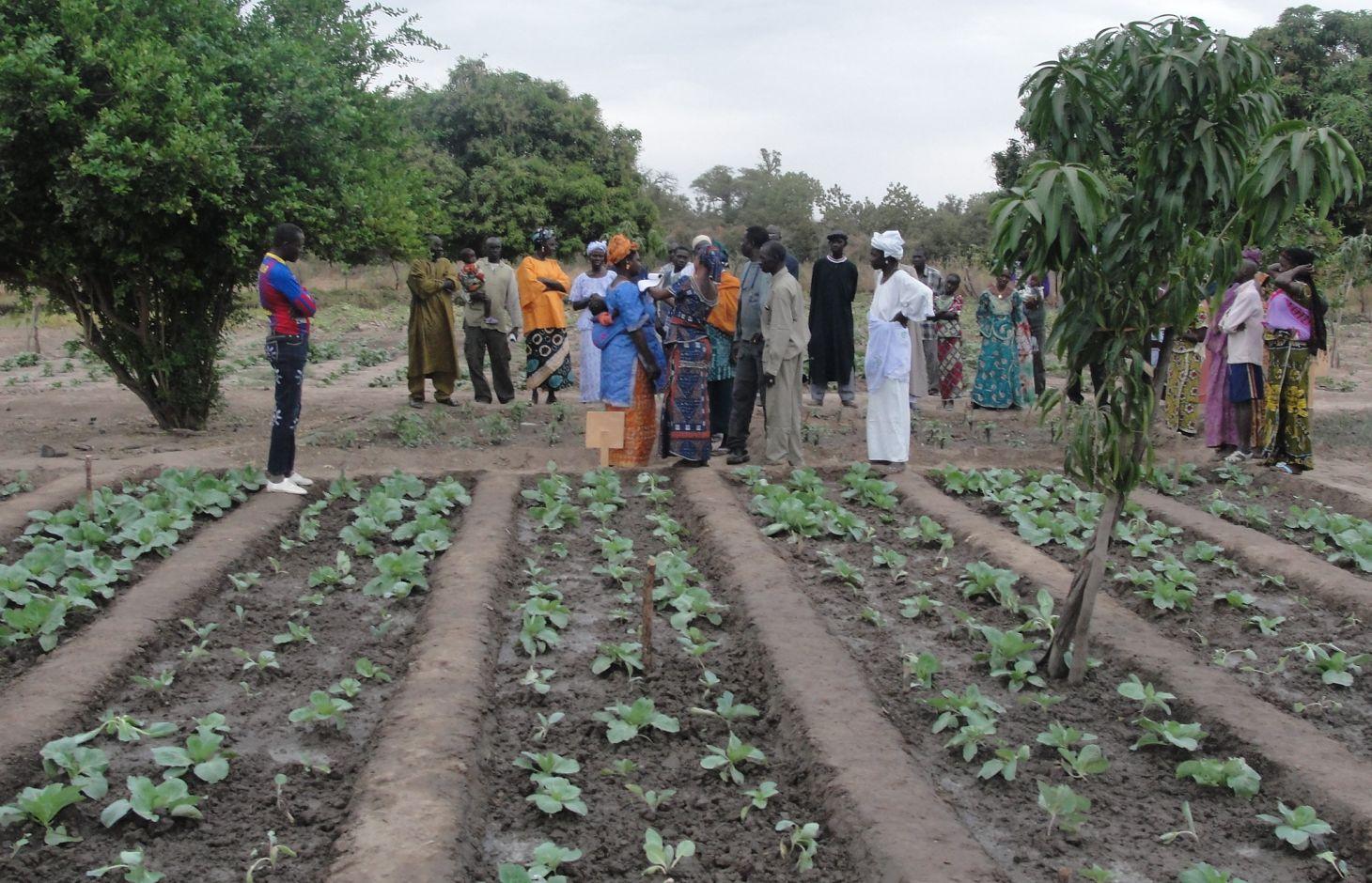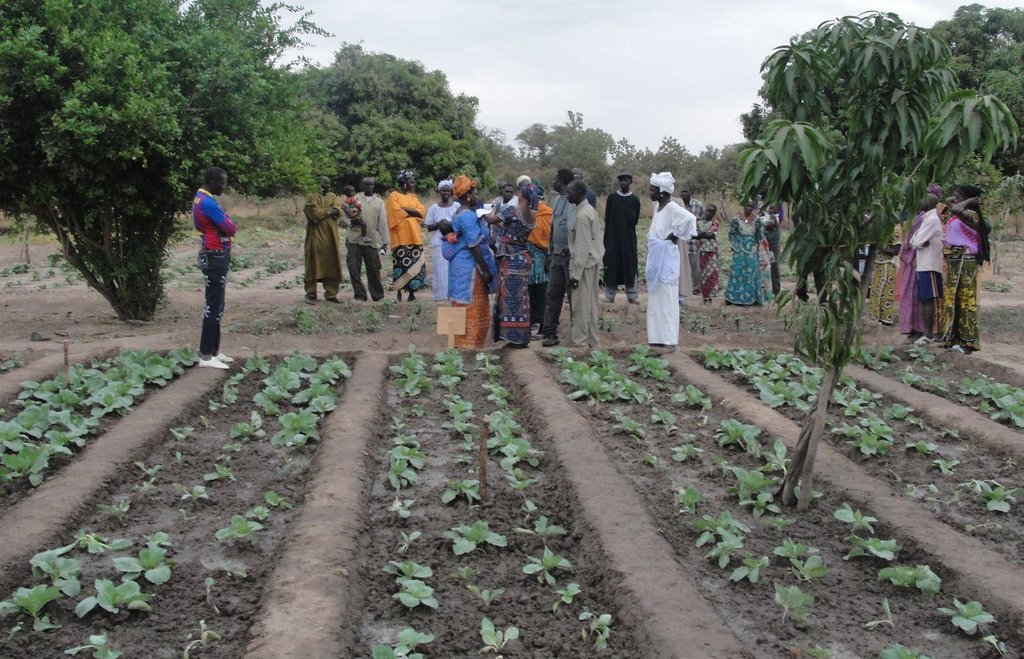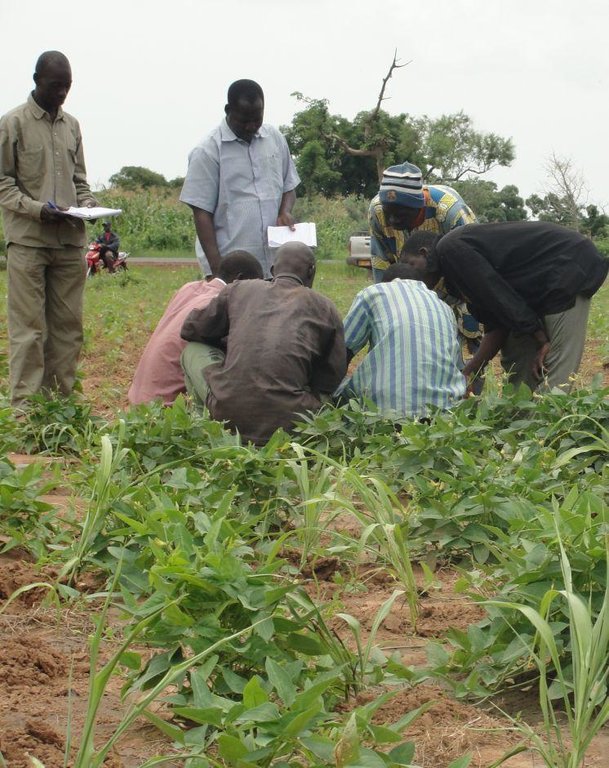Integrated Production and Pest Management (IPPM) [Mali]
- Creation:
- Update:
- Compiler: Dieter Nill
- Editor: –
- Reviewers: Fabian Ottiger, Alexandra Gavilano
Gestion intégrée de la production et des déprédateurs (GIPD) (French)
technologies_1653 - Mali
View sections
Expand all Collapse all1. General information
1.2 Contact details of resource persons and institutions involved in the assessment and documentation of the Technology
SLM specialist:
Dako Jean Parfait
Direction Nationale de l'Agriculture
Mali
Name of project which facilitated the documentation/ evaluation of the Technology (if relevant)
Manual of Good Practices in Small Scale Irrigation in the Sahel (GIZ )Name of the institution(s) which facilitated the documentation/ evaluation of the Technology (if relevant)
Deutsche Gesellschaft für Internationale Zusammenarbeit (GIZ) GmbH (GIZ) - GermanyName of the institution(s) which facilitated the documentation/ evaluation of the Technology (if relevant)
Direction Nationale de l'Agriculture (DNA) - Mali1.3 Conditions regarding the use of data documented through WOCAT
The compiler and key resource person(s) accept the conditions regarding the use of data documented through WOCAT:
Yes
1.4 Declaration on sustainability of the described Technology
Is the Technology described here problematic with regard to land degradation, so that it cannot be declared a sustainable land management technology?
No
2. Description of the SLM Technology
2.1 Short description of the Technology
Definition of the Technology:
IPPM reduces the negative impact wrought by pesticides on the environment (wildlife, water, soil) and on humankind
2.2 Detailed description of the Technology
Description:
Integrated Production and Pest Management (IPPM) curbs the environmental degradation caused by current farming practices (intensive and extensive), reducing the negative impact wrought by pesticides on the environment (wildlife, water, soil) and on humankind. IPPM promotes the adoption of farming practices that are as respectful of the environment as they are productive and profitable.
Purpose of the Technology: IPPM works with all available techniques for combatting pests, while keeping pesticide use at economically justified levels. It reduces risks to human and animal health and to the environment. It is put into practice in farmer field schools (FFSs).
Establishment / maintenance activities and inputs: Implementation: Men and women farmers are informed about the harmful effects of pesticide use. A group of local farmers are offered the opportunity to form a farmer field school led by a facilitator (with 25 farmers in each FFS group). The weekly sessions of the FFS focus on studying the presence
of insects and diseases and the condition of plants. The results are recorded in a study-findings logbook. Biopesticides like neem extract are used and their effectiveness is studied. Operation: Setting the critical thresholds for pest infestation of crops and evaluating the treatments required; Composing and applying pesticides according to the level of infestation.
Roles of the actors involved: Producers participate in the FFS and apply the techniques on their lands. Technical services provide training in good farming practices and link up the plant-disease and insect experts with the FFS facilitators. Research institutions make their plant-disease and insect experts available and train up the technical services.
Natural / human environment: Implementation locations: All regions throughout Mali. On going for around 12 years. This technique is particularly popular with farmers. Trained facilitators and farming advisors are available.
2.3 Photos of the Technology
2.5 Country/ region/ locations where the Technology has been applied and which are covered by this assessment
Country:
Mali
Region/ State/ Province:
Mali
Map
×2.6 Date of implementation
If precise year is not known, indicate approximate date:
- 10-50 years ago
2.7 Introduction of the Technology
Specify how the Technology was introduced:
- through projects/ external interventions
3. Classification of the SLM Technology
3.1 Main purpose(s) of the Technology
- reduce, prevent, restore land degradation
- preserve/ improve biodiversity
- create beneficial social impact
3.2 Current land use type(s) where the Technology is applied

Cropland
- Annual cropping
Number of growing seasons per year:
- 1
Specify:
Longest growing period in days: 120, Longest growing period from month to month: August-November
Comments:
Major land use problems (compiler’s opinion): environmental degradation caused by current farming practices (intensive and extensive)
3.4 Water supply
Water supply for the land on which the Technology is applied:
- mixed rainfed-irrigated
3.5 SLM group to which the Technology belongs
- integrated pest and disease management (incl. organic agriculture)
3.6 SLM measures comprising the Technology

management measures
- M7: Others
Comments:
Specification of other management measures: combatting pests
3.7 Main types of land degradation addressed by the Technology

biological degradation
- Bp: increase of pests/ diseases, loss of predators
Comments:
Main causes of degradation: soil management (Unadapted landuse methods, reduced or abandoned fallow periods), crop management (annual, perennial, tree/shrub) (negative impact of pesticides, neglect of fallow periods and crop rotation), droughts (due to heat waves), population pressure (rapidly growing population increasing pressure on land), land tenure (insecure access to land and collectively managed communal land), poverty / wealth (very poor population)
Secondary causes of degradation: deforestation / removal of natural vegetation (incl. forest fires) (deforestation through overgrazing and fire wood collection), over-exploitation of vegetation for domestic use (firewood collection), overgrazing (cattle, sheep and goats), change in temperature (Climate change: heat waves), change of seasonal rainfall (more variable onset of rain), Heavy / extreme rainfall (intensity/amounts) (more variable and intensive rains), wind storms / dust storms (frequent storms), floods (due to intensive rain storms), labour availability (some migration of men to nearby cities), education, access to knowledge and support services (high level of illiteracy)
3.8 Prevention, reduction, or restoration of land degradation
Specify the goal of the Technology with regard to land degradation:
- prevent land degradation
- reduce land degradation
4. Technical specifications, implementation activities, inputs, and costs
4.1 Technical drawing of the Technology
Technical specifications (related to technical drawing):
Technical knowledge required for field staff / advisors: high
Technical knowledge required for land users: low
Main technical functions: combatting pests, change in farming practices
Other type of management: IPPM works with all available techniques for combatting pests, while keeping pesticide use at economically justified levels. Adoption of respectful farming practices.
5. Natural and human environment
5.1 Climate
Annual rainfall
- < 250 mm
- 251-500 mm
- 501-750 mm
- 751-1,000 mm
- 1,001-1,500 mm
- 1,501-2,000 mm
- 2,001-3,000 mm
- 3,001-4,000 mm
- > 4,000 mm
Agro-climatic zone
- semi-arid
Thermal climate class: tropics
5.2 Topography
Slopes on average:
- flat (0-2%)
- gentle (3-5%)
- moderate (6-10%)
- rolling (11-15%)
- hilly (16-30%)
- steep (31-60%)
- very steep (>60%)
Landforms:
- plateau/plains
- ridges
- mountain slopes
- hill slopes
- footslopes
- valley floors
Altitudinal zone:
- 0-100 m a.s.l.
- 101-500 m a.s.l.
- 501-1,000 m a.s.l.
- 1,001-1,500 m a.s.l.
- 1,501-2,000 m a.s.l.
- 2,001-2,500 m a.s.l.
- 2,501-3,000 m a.s.l.
- 3,001-4,000 m a.s.l.
- > 4,000 m a.s.l.
5.3 Soils
Soil depth on average:
- very shallow (0-20 cm)
- shallow (21-50 cm)
- moderately deep (51-80 cm)
- deep (81-120 cm)
- very deep (> 120 cm)
Soil texture (topsoil):
- medium (loamy, silty)
- fine/ heavy (clay)
Topsoil organic matter:
- medium (1-3%)
- low (<1%)
If available, attach full soil description or specify the available information, e.g. soil type, soil PH/ acidity, Cation Exchange Capacity, nitrogen, salinity etc.
Soil fertility: Medium
Soil drainage/infiltration: Medium and poor
Soil water storage capacity: Medium
5.4 Water availability and quality
Ground water table:
5-50 m
Availability of surface water:
medium
Water quality (untreated):
for agricultural use only (irrigation)
Comments and further specifications on water quality and quantity:
Availability of surface water: Also poor/ none
5.5 Biodiversity
Species diversity:
- medium
5.6 Characteristics of land users applying the Technology
Market orientation of production system:
- mixed (subsistence/ commercial)
Off-farm income:
- 10-50% of all income
Relative level of wealth:
- poor
- average
Level of mechanization:
- manual work
Gender:
- men
Indicate other relevant characteristics of the land users:
Population density: < 10 persons/km2
Annual population growth: 2% - 3%
10% of the land users are rich.
50% of the land users are average wealthy.
30% of the land users are poor.
10% of the land users are poor.
5.7 Average area of land used by land users applying the Technology
- < 0.5 ha
- 0.5-1 ha
- 1-2 ha
- 2-5 ha
- 5-15 ha
- 15-50 ha
- 50-100 ha
- 100-500 ha
- 500-1,000 ha
- 1,000-10,000 ha
- > 10,000 ha
Is this considered small-, medium- or large-scale (referring to local context)?
- small-scale
5.8 Land ownership, land use rights, and water use rights
Comments:
The irrigated area is allocated by the chief
5.9 Access to services and infrastructure
health:
- poor
- moderate
- good
education:
- poor
- moderate
- good
technical assistance:
- poor
- moderate
- good
employment (e.g. off-farm):
- poor
- moderate
- good
markets:
- poor
- moderate
- good
energy:
- poor
- moderate
- good
roads and transport:
- poor
- moderate
- good
drinking water and sanitation:
- poor
- moderate
- good
financial services:
- poor
- moderate
- good
6. Impacts and concluding statements
6.1 On-site impacts the Technology has shown
Socio-economic impacts
Production
crop production
risk of production failure
Water availability and quality
water availability for livestock
water quality for livestock
Income and costs
expenses on agricultural inputs
Comments/ specify:
Reduced use of pesticides
Socio-cultural impacts
food security/ self-sufficiency
health situation
Comments/ specify:
Reduced risk to human and animal health and to the environment
SLM/ land degradation knowledge
situation of socially and economically disadvantaged groups
Improved livelihoods and human well-being
Comments/ specify:
IPPM promotes the adoption of farming practices that are as respectful of the environment as they are productive and profitable. It reduces risks to human and animal health and to the environment.
Ecological impacts
Water cycle/ runoff
water quality
Biodiversity: vegetation, animals
plant diversity
animal diversity
beneficial species
habitat diversity
pest/ disease control
Climate and disaster risk reduction
emission of carbon and greenhouse gases
6.3 Exposure and sensitivity of the Technology to gradual climate change and climate-related extremes/ disasters (as perceived by land users)
Gradual climate change
Gradual climate change
| Season | increase or decrease | How does the Technology cope with it? | |
|---|---|---|---|
| annual temperature | increase | well |
Climate-related extremes (disasters)
Meteorological disasters
| How does the Technology cope with it? | |
|---|---|
| local rainstorm | not well |
| local windstorm | well |
Climatological disasters
| How does the Technology cope with it? | |
|---|---|
| drought | well |
Hydrological disasters
| How does the Technology cope with it? | |
|---|---|
| general (river) flood | well |
Other climate-related consequences
Other climate-related consequences
| How does the Technology cope with it? | |
|---|---|
| reduced growing period | well |
6.4 Cost-benefit analysis
How do the benefits compare with the establishment costs (from land users’ perspective)?
Short-term returns:
positive
Long-term returns:
very positive
How do the benefits compare with the maintenance/ recurrent costs (from land users' perspective)?
Short-term returns:
very positive
Long-term returns:
very positive
6.5 Adoption of the Technology
Comments:
There is a moderate trend towards spontaneous adoption of the Technology
Comments on adoption trend: Implementation locations: All regions throughout Mail.
Scope of application: All farmed basins.
Duration of application: On going for around 12 years
6.7 Strengths/ advantages/ opportunities of the Technology
| Strengths/ advantages/ opportunities in the compiler’s or other key resource person’s view |
|---|
| Reduction in pest control costs |
| Farm production is healthier and the environment is better protected |
| The use of pesticides for safeguarding production in rural areas is now very low. |
| Reduction of the negative impact wrought by pesticides on the environment (wildlife, water, soil) and on humankind |
6.8 Weaknesses/ disadvantages/ risks of the Technology and ways of overcoming them
| Weaknesses/ disadvantages/ risks in the compiler’s or other key resource person’s view | How can they be overcome? |
|---|---|
| The village facilitators and farmers participating in the FFS must be literate | |
| IPPM requires inputs from plant-disease and insect experts |
7. References and links
7.1 Methods/ sources of information
- field visits, field surveys
- interviews with land users
When were the data compiled (in the field)?
01/07/2012
7.2 References to available publications
Title, author, year, ISBN:
Annual reports for 2010, 2011 and 2012 – IPPM/DNA
7.3 Links to relevant online information
Title/ description:
Manual of Good Practices in Small Scale Irrigation in the Sahel. Experiences from Mali. Published by GIZ in 2014.
URL:
http://star-www.giz.de/starweb/giz/pub/servlet.starweb
Links and modules
Expand all Collapse allLinks
No links
Modules
No modules





